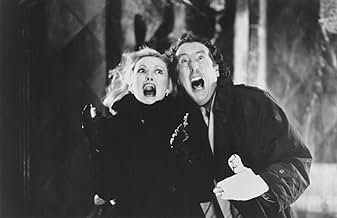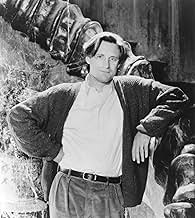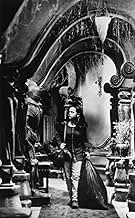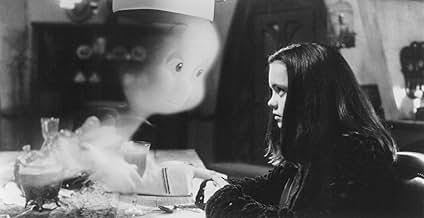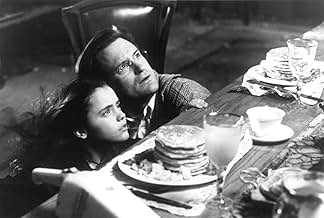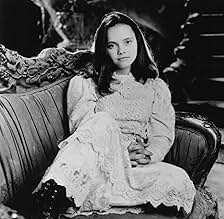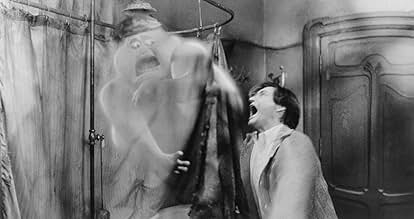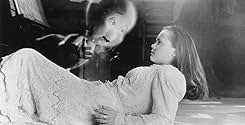Um investigador do paranormal e sua filha entram em uma casa abandonada, povoada por três fantasmas desobedientes e um amigo amigável.Um investigador do paranormal e sua filha entram em uma casa abandonada, povoada por três fantasmas desobedientes e um amigo amigável.Um investigador do paranormal e sua filha entram em uma casa abandonada, povoada por três fantasmas desobedientes e um amigo amigável.
- Direção
- Roteiristas
- Artistas
- Prêmios
- 5 vitórias e 5 indicações no total
Malachi Pearson
- Casper
- (narração)
Fred Rogers
- Mr. Rogers
- (cenas de arquivo)
- (as Mr. Rogers)
Doug Bruckner
- Reporter
- (narração)
- (as Douglas J.O. Bruckner)
Joe Nipote
- Stretch
- (narração)
Joe Alaskey
- Stinkie
- (narração)
Brad Garrett
- Fatso
- (narração)
John Kassir
- The Crypt Keeper
- (narração)
- Direção
- Roteiristas
- Elenco e equipe completos
- Produção, bilheteria e muito mais no IMDbPro
Avaliações em destaque
One of many children Halloween movies . I'll recommend a ghostly comedy. Especially about a friendly ghost named CASPER and his three ghosts brothers Fatso, Stretch, Stinkie. This funniest laughter ghosts that knock your socks off. Also is a family movie night . The leading roles is well acted. Christina Ricci as her character Kate and Bill Pullman character Dr. James Harvey perfect actors. Well done.
Forget the story. Forget the characters; forget even the kids and rent this just to be able to see Whipstaff Manor.
For me a film can be rewarding if just one element (in practical terms, it has to be an element I can recognize) is best in class. Here, it is the absolutely engaging set.
At the end of the 19th century, a style of art, essentially a fad, swept over Europe: Art Nouveau. This focused on natural forms and continuous lines. Done well in drawing and sculpture, its quite charming. At the same time, there was a crisis in architecture as the first real architects sought solutions to how internal space affects the psyche. For only a decade or so, architects tried to employ art nouveau in their work.
The problem is that the two just don't naturally mix: it's as if someone tried to do a swimmingpool production of Hamlet. But two geniuses partly succeeded in a few experiments: Horta in Brussels and Gaudi in Barcelona. In their lives their experiments were rejected by the public and critics. Today, they are among only a few valued gems of modern architectural history we have.
So much for background. What we have in Whipstaff Manor is a reworking of Gaudi, with some elements of Horta in entry and staircase. This is notable for a couple reasons:
---The primary mission of a film is to convey a tone, ideally an unfamiliar one. Sometimes cinematography is the tool of reliance, sometimes costumes, sometimes surreal plot twists, rarely acting posture. Rarely, rarely is the set the star. The goal of Gaudi was to (in a very literal sense) raise spirits by the form of the space. See how you feel in the bedroom/corridor and `livingroom' spaces. The attic was done by a lesser talent and the cellar isn't part of this discussion. But the main house draws on some deeply spooky center of the mind.
---The second notable comment is the sheer difficulty of what the set designers have done. Gaudi, an absolute master, had difficulty pulling off what he did. Here, the Casperites had an even greater challenge: when I go in a space, the relationship between me and the space is intimate; just a simple dialog. But when the space is presented through a medium, the designers have to dramatically exaggerate elements so the combined effect appears `normal.' Its the same as with what actors must do as compared to ordinary people you encounter; but an environment is more complex, more multidimensional, less semiotically loaded than a person. Mastering this greater palette of form is remarkable, and that's before you even accommodate the physical needs of production (camera placement, sound wiring...)
Check this out; it's interesting. Just based on the set, I place this in my best films list.
For me a film can be rewarding if just one element (in practical terms, it has to be an element I can recognize) is best in class. Here, it is the absolutely engaging set.
At the end of the 19th century, a style of art, essentially a fad, swept over Europe: Art Nouveau. This focused on natural forms and continuous lines. Done well in drawing and sculpture, its quite charming. At the same time, there was a crisis in architecture as the first real architects sought solutions to how internal space affects the psyche. For only a decade or so, architects tried to employ art nouveau in their work.
The problem is that the two just don't naturally mix: it's as if someone tried to do a swimmingpool production of Hamlet. But two geniuses partly succeeded in a few experiments: Horta in Brussels and Gaudi in Barcelona. In their lives their experiments were rejected by the public and critics. Today, they are among only a few valued gems of modern architectural history we have.
So much for background. What we have in Whipstaff Manor is a reworking of Gaudi, with some elements of Horta in entry and staircase. This is notable for a couple reasons:
---The primary mission of a film is to convey a tone, ideally an unfamiliar one. Sometimes cinematography is the tool of reliance, sometimes costumes, sometimes surreal plot twists, rarely acting posture. Rarely, rarely is the set the star. The goal of Gaudi was to (in a very literal sense) raise spirits by the form of the space. See how you feel in the bedroom/corridor and `livingroom' spaces. The attic was done by a lesser talent and the cellar isn't part of this discussion. But the main house draws on some deeply spooky center of the mind.
---The second notable comment is the sheer difficulty of what the set designers have done. Gaudi, an absolute master, had difficulty pulling off what he did. Here, the Casperites had an even greater challenge: when I go in a space, the relationship between me and the space is intimate; just a simple dialog. But when the space is presented through a medium, the designers have to dramatically exaggerate elements so the combined effect appears `normal.' Its the same as with what actors must do as compared to ordinary people you encounter; but an environment is more complex, more multidimensional, less semiotically loaded than a person. Mastering this greater palette of form is remarkable, and that's before you even accommodate the physical needs of production (camera placement, sound wiring...)
Check this out; it's interesting. Just based on the set, I place this in my best films list.
There's something enormously touching about this film and the way it deals with losses -- Pullman's wife and Casper's mother, in particular. And what's so clever about it is how it uses them as a tool of audience manipulation AND has the evil ghosts use Pullman in exactly the same way that we're being used. This is a smartly written screenplay. The story itself is pretty conventional and predictable: the loner girl gets teased by a popular girl (that nobody really likes) who's out to destroy her; the popular girl has a cute boyfriend that the loner girl has the hots for, etc. etc., story will resolve itself with everyone falling in love with loner girl.
I can't quite understand why this movie has such a low rating. The only explanation I can think of is that people prefer emotionally "safe" movies like "Toy Story" (of the same year) that are equally brilliant technically (and have as many references), but don't sacrifice coolness by showing sentimental, sad emotion. It's possible that the movie got marketed incorrectly. The film isn't about spooks; like one of those early, wonderful Tim Burton fantasies (this film also shares with them an outstanding score), the film deals -- quite movingly, I think -- with regaining that lost sense of childhood: that moment where Casper tries to remember being alive is just wrenching. And the scene relates just as profoundly to us: just as he can't remember being alive, we can't, really, remember being kids. I was ten when I first saw this, and it had an effect on me then (Ricci's description of sunny side-up eggs making her gag subconsciously made me avoid anything less than hard boiled for ten years); this is something that I really cherish as being part of my young emotional and visual education, and it stands up today.
I haven't seen the director's other films, so I have no idea whether this whole thing was a fluke or whether everything just settled in to my particular sensibility, but even outside of the emotion I think the technical aspects, the giant basement set, are enough to keep interest. And even outside of that, the acting is terrific. Cathy Moriarty is an absolute riot. 7/10
I can't quite understand why this movie has such a low rating. The only explanation I can think of is that people prefer emotionally "safe" movies like "Toy Story" (of the same year) that are equally brilliant technically (and have as many references), but don't sacrifice coolness by showing sentimental, sad emotion. It's possible that the movie got marketed incorrectly. The film isn't about spooks; like one of those early, wonderful Tim Burton fantasies (this film also shares with them an outstanding score), the film deals -- quite movingly, I think -- with regaining that lost sense of childhood: that moment where Casper tries to remember being alive is just wrenching. And the scene relates just as profoundly to us: just as he can't remember being alive, we can't, really, remember being kids. I was ten when I first saw this, and it had an effect on me then (Ricci's description of sunny side-up eggs making her gag subconsciously made me avoid anything less than hard boiled for ten years); this is something that I really cherish as being part of my young emotional and visual education, and it stands up today.
I haven't seen the director's other films, so I have no idea whether this whole thing was a fluke or whether everything just settled in to my particular sensibility, but even outside of the emotion I think the technical aspects, the giant basement set, are enough to keep interest. And even outside of that, the acting is terrific. Cathy Moriarty is an absolute riot. 7/10
Who says there are no such things as ghosts? Not if there is the ghostly inhabitants of Whipstaff Manor in Friendship, Maine! This desolate mansion is then, in the words of one of the members of the Ghostly Trio of Whipstaff, 'intruded' by Kat Harvey (Christina Ricci) and her eccentric father Dr. James Harvey (Bill Pullman), a ghost therapist. Carrigan Crittenden (Cathy Moriarty) had hired Dr. Harvey to exorcise the ghosts, including Casper the friendly ghost and his three obnoxious uncles, Stretch, Fatso and Stinkie, aspiring to gain Whipstaff's 'buried gold'.
Intertwining humour, all-time fun and a modern Cinderella story, 'Casper' promises to please as a movie which is compelling, hilarious, captivating, heart-warming, witty and above all, truly 'fleshtastic'.
'Casper' is recommended for any audience, regardless of age. At the time I am submitting this review I am currently 17, turning 18, but 'Casper' still manages to appear endearing and ultimately special. The magic of Bill Pullman, Christina Ricci as well as that of director Brad Silberling, executive producer Steven Spielberg, and other producers weaves between each and every scene to eventually lift us off our feet. Above all, I LOVE THIS MOVIE! Casper is my all time favourite character. Truly fantastic. You won't BOOlieve it until you see it.
Intertwining humour, all-time fun and a modern Cinderella story, 'Casper' promises to please as a movie which is compelling, hilarious, captivating, heart-warming, witty and above all, truly 'fleshtastic'.
'Casper' is recommended for any audience, regardless of age. At the time I am submitting this review I am currently 17, turning 18, but 'Casper' still manages to appear endearing and ultimately special. The magic of Bill Pullman, Christina Ricci as well as that of director Brad Silberling, executive producer Steven Spielberg, and other producers weaves between each and every scene to eventually lift us off our feet. Above all, I LOVE THIS MOVIE! Casper is my all time favourite character. Truly fantastic. You won't BOOlieve it until you see it.
Ever since i was six years of age, I've enjoyed this movie. It makes me laugh, cry, and excited! i am disappointed that so many people don't like this movie. it is an all-time favorite of mine. It is sad yes, but it has comic relief from the three uncles that try to be humanlike, Casper, the friendly ghost that knows what it is like to be lonely, for instance me, and same with Kat. I am very touched with this film, for it makes me think about me, lonely and depressed, but it has a positive ending which I really adored! i also liked the amazing effects, that were famous at its, time. Of course now, effects from movies are like The Matrix films and LOTR, but i mainly like this film, because it tocuhes my heart in a both sad and sometimes happy, knowing, someone else is out there for you, even if you are a bit...dead. 10/10
Você sabia?
- CuriosidadesThis is the first feature film to have a fully computer-generated visual effects character in a leading role.
- Erros de gravaçãoCasper tells Kat that he can't hurt her, and then makes his hand go though hers to show that ghosts cannot touch living beings. Yet multiple times ghosts touch people. However, Casper hesitates before answering (notice how quickly he says that she can't hurt him), and shortly after grabs Kat to drag her out the window. Casper knows that ghosts can touch people, and may not want to scare Kat away by admitting it.
- Citações
Dr. Raymond Stantz: [runs out of the house frantic] Who you gonna call? Someone else.
- Cenas durante ou pós-créditosThe globe in the Universal logo fades into a full moon above Whipstaff Manor.
- ConexõesEdited into Casper: Deleted Scene #91: Lucky Enough to Be a Ghost (2003)
- Trilhas sonorasCasper The Friendly Ghost
Written by Mack David and Jerry Livingston
Performed by Little Richard
Produced by Richie Zito and Little Richard
Arranged by Richie Zito
Principais escolhas
Faça login para avaliar e ver a lista de recomendações personalizadas
- How long is Casper?Fornecido pela Alexa
Detalhes
- Data de lançamento
- País de origem
- Central de atendimento oficial
- Idioma
- Também conhecido como
- Casper: el fantasma amigable
- Locações de filme
- Rockport, Maine, EUA(Anonymous)
- Empresas de produção
- Consulte mais créditos da empresa na IMDbPro
Bilheteria
- Orçamento
- US$ 55.000.000 (estimativa)
- Faturamento bruto nos EUA e Canadá
- US$ 100.544.179
- Fim de semana de estreia nos EUA e Canadá
- US$ 16.840.385
- 28 de mai. de 1995
- Faturamento bruto mundial
- US$ 288.144.179
- Tempo de duração
- 1 h 40 min(100 min)
- Cor
- Mixagem de som
- Proporção
- 1.85 : 1
Contribua para esta página
Sugerir uma alteração ou adicionar conteúdo ausente



